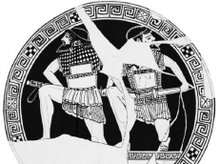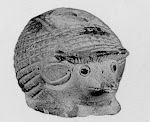What is the benefit of a curved shield? Shields with curved profiles are common, but there is a wide variety in their profiles and the benefits they convey. As shown in the previous post, Assyrian shields were cone-shaped in profile. The sloped shield-face provides increased protection from penetration in a manner that will be familiar to students of the development of WWII tanks and the advent of "sloped armor." Simply because for any thickness of a plane of armor a diagonal path through it will always be longer than a perpendicular path straight across it, a sloped shield acts as though it were thicker than it actually is when blocking a frontal attack.

 Another famously curved shield is the Roman scutum. The example at left is from Dura Europos, the image is from the Yale Art Museum, and clearly shows the hemi-cylindrical shape. As well as the sloped-armor effect, curvature can provide enhanced protection from chopping attacks. This one is a little more complicated, but obvious if we understand how weapons are designed to cut. The whole reason for a fine "edge" on a sword or axe is to transfer the total energy of a thick, heavy weapon to the target through the minimum area of contact. This focusses the force and allows cutting.
Another famously curved shield is the Roman scutum. The example at left is from Dura Europos, the image is from the Yale Art Museum, and clearly shows the hemi-cylindrical shape. As well as the sloped-armor effect, curvature can provide enhanced protection from chopping attacks. This one is a little more complicated, but obvious if we understand how weapons are designed to cut. The whole reason for a fine "edge" on a sword or axe is to transfer the total energy of a thick, heavy weapon to the target through the minimum area of contact. This focusses the force and allows cutting.
With a flat shield, a chopping sword will impact the rim along only a few millimeters of razor-thin edge. The way to avoid this is to try and hold the shield-face parallel to the incoming blade, but this is difficult to do consistently. If the sword strikes along the shield-face instead of impacting the rim, then rather than a few millimeters of edge, much of the length of the sword will strike simultaneously. You might think that this is irrelevant since the edge is sharp, but the total area over which the force is transmitted increases. This is conceptually the same way that even long, narrow skis spread ones weight over the surface of soft snow and allow it to be passed over. As shown below, a curved shield provides less protection than an impact along the whole shield-face, but much more than the rim alone. The true benefit is that you do not need to try and intercept the incoming blow with the flat of the shield, a strike cannot avoid it.

 The aspis can benefit from both of these effects, but it is poorly designed to do so. It has a relatively flat face when compared with the Assyrian shield, so much of the face is not appreciably sloped. The curved "shoulders" of the aspis are confined to a narrow band just before the rim, so the benefit is confined to blows striking the edge. The fact that the aspis invariably posseses a robust, often metal sheathed, offset rim make added defense against chopping strikes to the rim a low priority.
The aspis can benefit from both of these effects, but it is poorly designed to do so. It has a relatively flat face when compared with the Assyrian shield, so much of the face is not appreciably sloped. The curved "shoulders" of the aspis are confined to a narrow band just before the rim, so the benefit is confined to blows striking the edge. The fact that the aspis invariably posseses a robust, often metal sheathed, offset rim make added defense against chopping strikes to the rim a low priority.

The aspis seems to not have been designed to capitalize on protective advantages of a curved shape, so why was it so characteristically curved? In the next post I shall examine the shape of the aspis in detail.










No comments:
Post a Comment